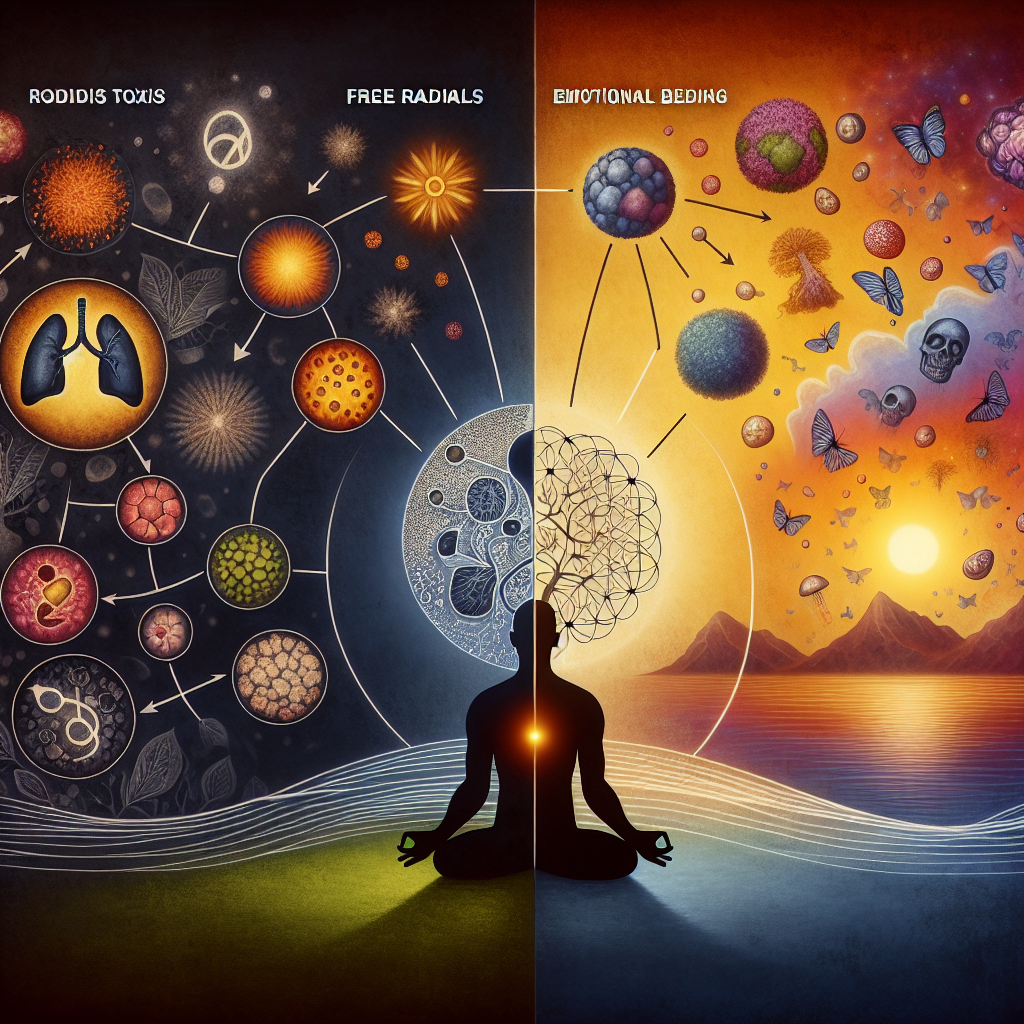
Exploring the Roots of Disease: The Impact of Toxins, Free Radicals, and Emotional Health.
Understanding the Origins of Disease: Toxins, Free Radicals, and Emotional Influence.
1. Where, When, What, and How Does Disease Start?
Disease starts at the cellular level, often triggered by a combination of toxins, oxidative stress, poor nutrition, and emotional distress. It can originate anywhere in the body, depending on the toxins, lifestyle, and genetic predisposition of an individual.
• Where? Disease starts in the cells, particularly in the mitochondria and DNA, when they become damaged by free radicals, toxins, and inflammation.
• When? It can take years or decades for chronic diseases to develop, but some acute conditions (e.g., poisoning, infections) appear rapidly.
• What? The root cause is often an imbalance in oxidative stress, inflammation, and immune dysfunction.
• How? Over time, exposure to harmful substances, poor diet, stress, and negative emotions contribute to cellular damage, leading to chronic disease.
2. Is Disease Caused by Toxins?
Yes, toxins are a major contributor to disease. Environmental and internal toxins can overload the body’s detoxification systems, leading to oxidative stress and inflammation.
Common Sources of Toxins:
• Environmental: Air pollution, pesticides, heavy metals (lead, mercury, aluminum), plastics (BPA), radiation, and EMFs.
• Dietary: Processed foods, artificial additives, excessive sugar, trans fats, and GMOs.
• Emotional & Mental Stress: Chronic fear, anger, and resentment create biochemical changes that mimic toxin exposure.
Toxins accumulate over time, disrupting cellular function, damaging DNA, and impairing organ systems, increasing disease risk.
3. How Are Free Radicals Produced?
Free radicals are unstable molecules that steal electrons from healthy cells, causing damage in a process called oxidative stress. They are naturally produced in the body but become excessive due to external and internal stressors.
Sources of Free Radical Production:
• Toxic Exposure: Pesticides, heavy metals, pollution, cigarette smoke, alcohol, radiation, EMFs.
• Poor Diet: Fried foods, excess sugar, processed meats, artificial additives.
• Chronic Stress & Negative Emotions: Fear, anger, and trauma trigger excess cortisol and adrenaline, leading to oxidative stress.
• Inflammation & Infections: The immune system produces reactive oxygen species (ROS) during chronic infections.
• Nutrient Deficiency: Lack of antioxidants (Vitamin C, E, glutathione, selenium) reduces the body’s ability to neutralize free radicals.
When free radicals overwhelm the body’s natural antioxidant defenses, they damage cells, tissues, and DNA, increasing the risk of diseases like cancer, heart disease, and neurodegenerative disorders.
4. How Long Before Free Radical Damage Leads to Disease?
The time frame varies depending on the individual’s health, toxin exposure, and ability to detoxify.
• Short-Term Exposure (Months to Years): Can cause early symptoms like fatigue, brain fog, skin issues, and mild inflammation.
• Long-Term Exposure (5-30 Years): Leads to chronic diseases like cancer, heart disease, autoimmune conditions, diabetes, and neurodegenerative disorders.
• Generational Damage: DNA mutations from free radicals can be passed to offspring, increasing disease risk in future generations.
Factors that accelerate disease progression include:
- High toxin exposure (chemicals, heavy metals, EMFs)
- Chronic stress and negative emotions
- Poor diet and lack of antioxidants
- Weakened detoxification system (liver, kidneys, gut dysfunction)
5. How Does DNA Get Corrupted?
DNA corruption occurs when toxins, oxidative stress, and negative emotions damage genetic material, leading to mutations, poor cell replication, and chronic disease.
Ways DNA Gets Damaged:
• Oxidative Stress: Free radicals break DNA strands, causing mutations.
• Heavy Metals & Radiation: Disrupt DNA structure and cellular communication.
• Toxic Emotions: Chronic fear, anger, and resentment produce stress hormones that increase DNA damage.
• Nutritional Deficiencies: Lack of essential nutrients impairs DNA repair mechanisms.
• Cellular Inflammation: Chronic inflammation weakens immune function, allowing damaged DNA to persist.
Once DNA damage accumulates, the body struggles to correct mutations, leading to cancer, premature aging, neurodegenerative diseases, and weakened immunity.
6. Can Fear, Anger, and Negative Emotions Create Free Radicals and Affect DNA?
Yes! Emotional states like fear, anger, resentment, and stress generate free radicals and accelerate DNA damage.
How Negative Emotions Harm the Body:
1. Increase Cortisol & Adrenaline: Chronic stress hormones deplete antioxidants and increase inflammation.
2. Trigger Oxidative Stress: Emotional distress generates free radicals, damaging cells.
3. Weaken the Immune System: Fear and anger lower immunity, making the body vulnerable to toxins and disease.
4. Shorten Telomeres: Chronic stress shortens telomeres (protective DNA caps), leading to premature aging and disease.
Studies show meditation, gratitude, prayer, and positive thinking can reverse DNA damage, boost antioxidants, and improve healing.
Conclusion: Protecting Your Body from Disease & DNA Damage
To prevent disease and DNA corruption, focus on detoxification, nutrition, and emotional balance.
Detoxify: Support liver function with herbs (milk thistle, dandelion), drink clean water, and remove heavy metals.
Eat Antioxidant-Rich Foods: Berries, greens, turmeric, vitamin C, E, and glutathione help neutralize free radicals.
Reduce Emotional Stress: Practice meditation, gratitude, breathwork, and forgiveness.
Limit Toxin Exposure: Avoid processed foods, use natural cleaning products, and minimize EMF exposure.
Balance Hormones: Manage stress with adaptogens (ashwagandha, holy basil) and deep breathing exercises.
By reducing toxins, free radicals, and emotional stress, you protect your DNA, slow aging, and prevent disease, ensuring long-term health and vitality.

Leave a Reply